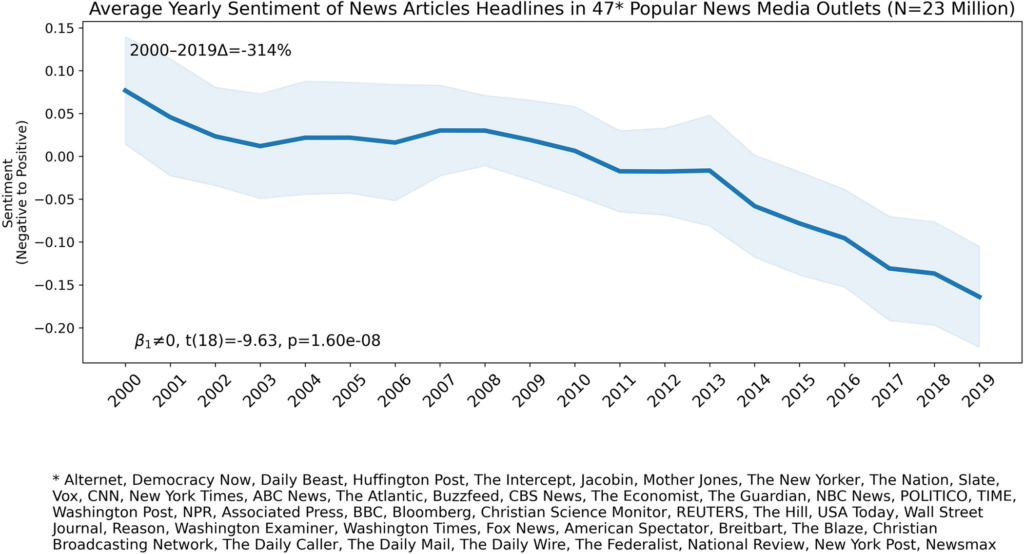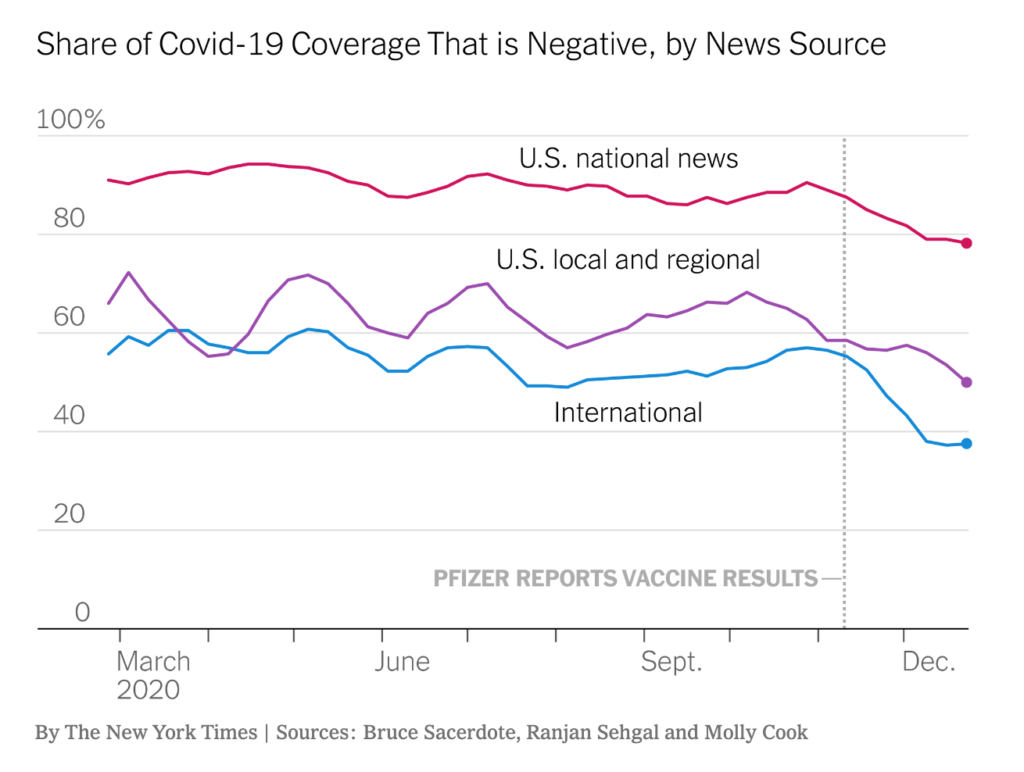Newsletter November 2, 2023
The (Political) News is Too Negative

News coverage of American politics is not known for an abundance of positivity. Lots of people have noted that our political coverage tends to be overwhelmingly negative. And it’s getting worse. Dylan Mathews at Vox recently reported on a 2022 study that documented a growing number of news organizations featuring negative emotions, namely “anger, fear, disgust and sadness,” in their headlines. Mathews says journalists are a “morose bunch.” But is it all journalists? Or are political reporters uniquely prone to cynicism?

It turns out that not all news is unrelentingly negative. In a recent report, we found that perceptions of news negativity varied substantially across topics. More than eight in ten (82 percent) Americans who say their preferred news topic is politics and government say the coverage was mostly negative. Only four percent said it was mostly positive. At the other end of the spectrum is science and technology. Sixty-two percent of Americans who follow news about science and technology report that the coverage leans positive.
If you’re exclusively focused on political news or international affairs, your sense of the world is going to be quite different than if your news diet is mostly science and technology. Studies that track negativity in headlines are almost certainly going to disproportionately sample political, financial, and international news: topics that skew more negative.
Why has this Happened?
There are some obvious reasons why political reporting has grown more negative. The economics of news reporting have changed—the Internet severely depressed advertising revenue and opened up more competition. The rapid growth of online news meant advertisers were paying for clicks, and negative content tends to produce more of them. The Atlantic’s Derek Thompson reported on a study earlier this year that found that “negative words in news headlines increased consumption rates.” The authors conclude that each additional negative word included in a headline increases the click-through rate by more than two percent. Scaring people and riling them up can be good for the bottom line.
But that’s not the only reason why negative news has increased. The decline of local news coverage played a role as well. In The Increasingly United States, political scientist Dan Hopkins documented the long decline of local news and the ways this has impacted American politics, from polarization to political activism. Over the last several decades, local news consumption plummeted as Americans turned to national news outlets increasingly published online. National news stories are far more likely to focus on political conflict and division, placing the negative aspects of America’s political system front and center.
A couple of years ago, New York Times writer David Leonhardt reported on research that found a substantial disparity in the way national, local, and international news outlets covered the COVID-19 pandemic. Leonhardt wrote: “The coverage by U.S. publications with a national audience has been much more negative than coverage by any other source that the researchers analyzed, including scientific journals, major international publications and regional U.S. media.” Is it any wonder that the tenor of our national pandemic conversation was so antagonistic?

Is Political Cynicism Alienating Young People?
Young adults may be particularly disinclined to follow negative news. They are already abandoning traditional news sources for social media at a rapid clip. Young people have typically shown less interest in political news than older Americans, but that’s less true when it comes to other news topics. Our May 2023 American Perspectives Survey found that seniors are roughly three times more likely than young people to report that they “often” follow news and current events (73 percent vs. 26 percent). But if you drill down and ask about what news topics people are interested in, the overall age gap in news attention drops.
Young people tend to gravitate to news topics—such as science and technology, entertainment, and sports—that typically include far more positive (or neutral) coverage. Put another way, they assiduously avoid news topics—such as politics—that are awash in negativity. The comparisons to older adults are stark.
A growing number of young people now say social media is their most trusted source for information. This is hardly shocking. But it does not mean that they have given up on journalism. According to Pew, 59 percent of young people have a great deal or a fair amount of confidence in journalists, a rate higher than the public overall.
Rather, like many Americans, young people are understandably tired of the way political news is presented. It’s not the job of the political press to boost the president’s popularity or reinvigorate public trust in Congress, but a relentless focus on negativity degrades the political process by increasing public cynicism and encouraging apathy. A new Pew poll finds that roughly two-thirds of Americans feel exhausted when they think about the state of American politics. A majority say they feel angry. Hope is in short supply.
In, perhaps, an acknowledgment of how pervasive news negativity has become, mainstream outlets have developed entire sections devoted to positive news. CBS News publishes The Uplift, dedicated to “stories that uplift and inspire,” while the New York Times publishes “The Week in Good News” to provide readers with a happiness boost. There are independent news sites, such as Upworthy or the Good News Network, exclusively focused on reporting upbeat stories. Even Fox News—not known for producing a lot of cheerful content—has a “Good News” section. At the time of writing, its lead item is about a dog helping a lost toddler stay warm in the woods. The problem with these efforts is that they mostly include human-interest stories of the type that you would see on a local news broadcast. For people interested in foreign affairs or government, these sites do not provide a meaningful alternative.
If technology and science reporters spent most of their time documenting the multitude of technical failures and setbacks as opposed to the breakthroughs, the public would have a very different understanding of human ingenuity and progress. The United States is a politically diverse place with a complex political system. There are positive political developments worth discussing, just as there is an audience ready to read about it.








